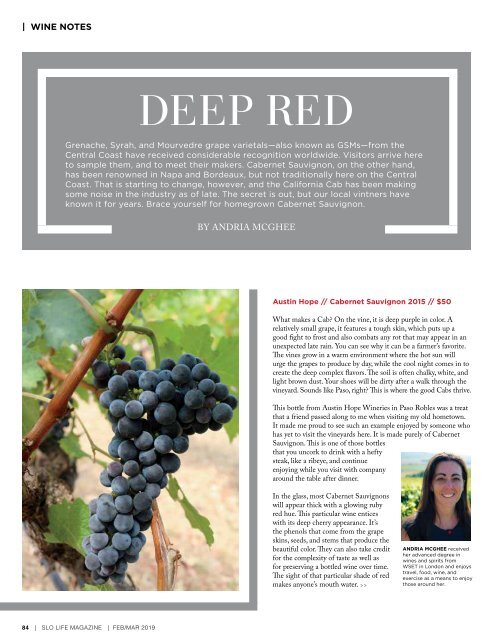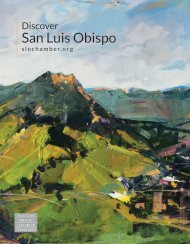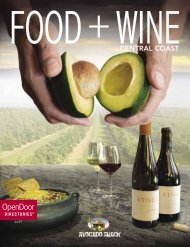You also want an ePaper? Increase the reach of your titles
YUMPU automatically turns print PDFs into web optimized ePapers that Google loves.
| WINE NOTES<br />
DEEP RED<br />
Grenache, Syrah, and Mourvedre grape varietals—also known as GSMs—from the<br />
Central Coast have received considerable recognition worldwide. Visitors arrive here<br />
to sample them, and to meet their makers. Cabernet Sauvignon, on the other hand,<br />
has been renowned in Napa and Bordeaux, but not traditionally here on the Central<br />
Coast. That is starting to change, however, and the California Cab has been making<br />
some noise in the industry as of late. The secret is out, but our local vintners have<br />
known it for years. Brace yourself for homegrown Cabernet Sauvignon.<br />
BY ANDRIA MCGHEE<br />
Austin Hope // Cabernet Sauvignon 2015 // $50<br />
What makes a Cab? On the vine, it is deep purple in color. A<br />
relatively small grape, it features a tough skin, which puts up a<br />
good fight to frost and also combats any rot that may appear in an<br />
unexpected late rain. You can see why it can be a farmer’s favorite.<br />
The vines grow in a warm environment where the hot sun will<br />
urge the grapes to produce by day, while the cool night comes in to<br />
create the deep complex flavors. The soil is often chalky, white, and<br />
light brown dust. Your shoes will be dirty after a walk through the<br />
vineyard. Sounds like Paso, right? This is where the good Cabs thrive.<br />
This bottle from Austin Hope Wineries in Paso Robles was a treat<br />
that a friend passed along to me when visiting my old hometown.<br />
It made me proud to see such an example enjoyed by someone who<br />
has yet to visit the vineyards here. It is made purely of Cabernet<br />
Sauvignon. This is one of those bottles<br />
that you uncork to drink with a hefty<br />
steak, like a ribeye, and continue<br />
enjoying while you visit with company<br />
around the table after dinner.<br />
In the glass, most Cabernet Sauvignons<br />
will appear thick with a glowing ruby<br />
red hue. This particular wine entices<br />
with its deep cherry appearance. It’s<br />
the phenols that come from the grape<br />
skins, seeds, and stems that produce the<br />
beautiful color. They can also take credit<br />
for the complexity of taste as well as<br />
for preserving a bottled wine over time.<br />
The sight of that particular shade of red<br />
makes anyone’s mouth water. >><br />
ANDRIA MCGHEE received<br />
her advanced degree in<br />
wines and spirits from<br />
WSET in London and enjoys<br />
travel, food, wine, and<br />
exercise as a means to enjoy<br />
those around her.<br />
84 | <strong>SLO</strong> <strong>LIFE</strong> MAGAZINE | FEB/MAR <strong>2019</strong>


















